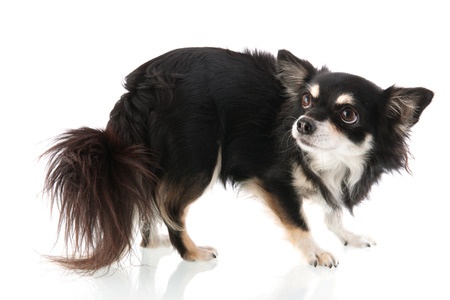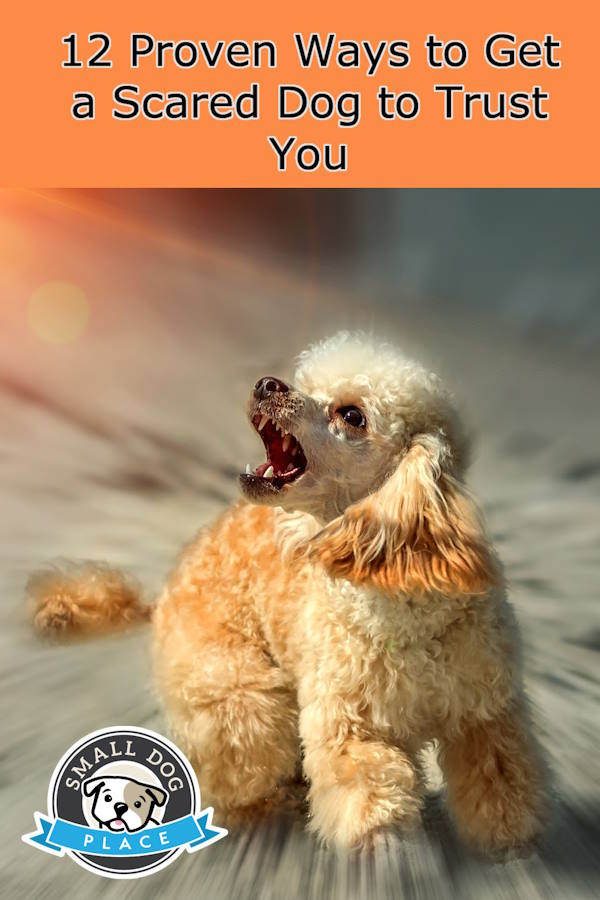- Small Dog Place Home
- Lifestyle
- Get a Scared Dog to Trust You
12 Proven Ways to Get a Scared Dog to Trust You
Those who adore small dogs love talking about their rambunctious personalities, often making them seem far ‘bigger’ than they are.
Small and big dogs can be scared of various things and experiences for many reasons—including lack of socialization, traumatic experiences, and exposure to loud noises. Empowering them to go through their daily lives (indoors and outdoors) with greater confidence and aplomb is vital to gain a scared dog’s trust is vital.
What if Your Pet is Scared of Human Beings?

Especially in the case of abused pets, the most significant source of fear can be people. You may have just adopted a small dog and noticed behavior indicating your pup fears you.
Typical behavior to watch out for includes evasion, cowering and hiding from you, raising or rounding his back, refusing snacks, growling at you, barking, hiding, shaking, pacing, and whining.
If your puppy behaves this way, it does not necessarily mean he has been abused. He may simply be adapting to a new environment, have a fearful personality, or not have had a chance to see the world and socialize with other dogs (and with people) during crucial development periods.
What Can You Do to Get a Scared Dog to Trust You?
Have you heard that old expression, "You never get a second chance to make a first impression?" While this adage typically refers to a meeting with another person, some may argue that it could also apply to meeting a dog.
Here are some typical ways that true dog lovers can gain the trust of a scared or shy dog.
1. Watch Your Own Body Language: opt for Gentle Body Language
In human culture, it is usual to look someone straight in the eye when speaking. Failing to do so can make it seem like you aren’t interested in what they say.
With dogs, however, sustained eye contact can feel like a threat. If your dog is scared, when you look at him, do so with slow movements, if possible, and don’t stare into his eyes.
If you need to approach him very slowly, walk in an arc shape towards him, if possible, instead of head-on.
Generally, very fast, brusque motions can be stressful for a dog that does not know you well yet. Move very slowly towards the dog.
To increase the likelihood of your little pooch approaching you, kneel with your side or back to him. This feels less threatening than if you walk towards him, especially if he is at one end of a narrow hallway or any other limited area.
Standing tall can be very threatening to small dogs especially if you lean over them. It's best to stand far enough away to feel less threatening and allow the dog to come to you.
If possible sit down with your side to them without talking and just sit very still.
Ways That Your Body Will Appear Nonthreatening to a Dog
- Make yourself smaller by kneeling, sitting, stooping
- Keep your side or back to the dog
- Avoid eye contact
- Speak quietly, or not at all
- Keep your movements smooth and slow
2. To Get a Scared Dog to Trust You, You Must Understand Dog Body Language
Dogs communicate through their body language and the easiest way to get a scared dog to trust you is to understand what he's trying to tell you through the way he responds with his body.
When dogs may be scared or wary of your presence, they may respond with certain body language cues.
- Turning his head away from you
- Shaking
- Licking his Lips
- Yawning
- Rolling over to show his belly
- Urinating
- Sometimes inappropriate pooping
- Lowering his head or cowering
- Tucking his tail between his legs
- Raising a paw
- Looking worried
- Panting
- Some dogs drool

Typical Dog Body Language Signs of a Nervous, Shy or Fearful dog:
- Looking Away
- Yawning
- Cowering
- Licking Lips



3. Understanding What Scares a Dog
So far, we have focused on a dog's fear of people, but there's much more to it than a generalized fear of humans.
It might be a fear of men, or a fear of people who cough, laugh or talk loudly. It could even be a fear of children.
Some fears can be traced to past abuse but still others may be a result of inadequate socialization or inexperience.
Just like people who develops fears of different things such as heights or spiders, dogs too may be fearful of more than one thing.
It's important to figure out what sets off the fear reaction but that takes a little investigation.
Do certain indoor or outdoor sounds startle the dog? (loud music, loud trucks outdoors, unusual sounds not heard before such as a helicopter hovering nearby)
4. Introducing the Element of Play
Dog behavior consultant, Sarah Dixon, suggests playing the Plate Game to increase your dog’s confidence.
This game involves placing a plate on the floor between you and your dog. This game works best in a room or space your dog is comfortable with, such as where she sleeps or rests.
Walk up to the plate and drop a piece of food your dog really loves—think a bit of grilled chicken breast, boiled meat, a chunk of tuna, or her favorite dog snack.
Then move away from the plate until your pooch feels safe enough to approach the plate. Take a break, then repeat it various times.
The Plate Game is easy and fun, and it teaches your dog a vital lesson: when you approach her, it’s for a good reason, not a bad one.
5. Use These Handy Tools To Get a Scared Dog to Trust You
When a dog is stressed (for instance, because it can hear fireworks), using a Thundershirt can help them feel more protected, in the same way, that swaddling can soothe a baby.
Some dogs also find it soothing when their ‘human’ puts their hand on the pet’s back, applying light pressure. This system works similarly to an anxiety blanket for human beings.
You can also try dog-appealing pheromones. These are synthetic versions of a chemical compound that lactating mother dogs release during nursing. Pheromones are commonly used in diffusers, sprays, or collars.
6. Eliminating Fear and Creating a Relationship of Equals
Your pet may be small, but you must let him know he is mighty! Create a genuine, deep relationship in which both of you are equals.
Food is a great way to start. Let your pup know that you store the food and that you will give it to him when he needs it.
If your dog is confident enough to come up to you, feed her once in a while with your hands so she associates the smell of your skin with food.
Be patient. For instance, if you would love her to join you on the couch, but she prefers to rest in her bed, wait until she comes up and sits by your side. The same goes for petting.
Some pets don’t like being caressed or only enjoy touching specific parts of their body (for instance, behind the ears and on the back close to the tail).
7.Treat and Retreat
Suzanne Clothier pioneered the “Retreat and Treat” method in the 1990s. In a very simplified explanation, a tasty reward is used with movement of the trainer (retreat). For example, the trainer would approach the dog with his side facing, wait for the dog to notice, then toss a treat. If the dog doesn't go for the treat, the trainer retreats.
8. Safe Places
Dogs are less fearful when they have a safe personal space that contains everything needed to feel secure: food, water, bed, and toys. Sometimes a crate may allow the dog to feel more secure.
This place must feel like their own and they should be allowed to retreat to their safe place when they need to do so.
9. Behavioral, Socialization and Obedience Classes
Invest in behavioral and socialization classes, so your dog has plenty of opportunities to learn acceptable behaviors. Find a small class with an experienced trainer and let the instructor know what you want to accomplish.
Shy or scared dogs do not do well when pressured to perform. Sitting on the sidelines and watching other dogs may be helpful when the scared dog is not motivated to move.
10. Behavior Modification
Systematic desensitization has long been one method used in human mental health counseling to deal with fears. Likewise, it has been used successfully with dogs as well.
Animal behaviorists use this method to present a systematic way to provide direct exposure to the feared object without causing a fearful response.
For example, if the dog is afraid of strange men, the first step might be to introduce a strange man at a distance. As the dog adjusts to the man's presence, the dog's owner may move a few steps closer to the man. It's meant to be a slow process so the dog does not react in a fearful way.
11. Counterconditioning
This method is often used in conjunction with the Systematic Desensitization described above.
The goal of Counter conditioning is to train the dog to show a different behavior or reaction than what he normally would do. When used with Systematic Desensitization, something positive (such as a high value treat) is paired with with the object of the fear.
Using the example above, if the dog is fearful of strange men, the stranger appears at a distance where the dog can still see him but does not provoke any threat.
At the same time, the dog is given some small tasty chicken or beef treats. The purpose is to convince the dog that wonderful things happen when the previous fear evoking stimulus appears.
It takes many repetitions, but over time, the goal is to have the dog feel relaxed and happy when the previous fear object appears.
12. Build Lasting Bonds
Once you've used one or more of the methods above to get your scared dog to trust you, now comes the bonding process.
That trust will help you develop the bond necessary to help the dog overcome any additional fears and learn to relax.
There are many ways to build a strong bond with a dog. Simple things such as cuddle time, training everyday, grooming, and developing a deeper understanding all builds strong bonds.
Get a Scared Dog to Trust You: Conclusion
Earning the trust of a scared dog takes time and patience. Sometimes, dogs are fearful because of negative experiences.
At other times, however, a dog might be a little more tentative, just like some people.
Allow your dog to socialize with other dogs and people, try valuable tools like the Thundershirt, and make sure your dog can always count on you for one of its primary needs—food.
Pin for Future Reference
Get a Scared Dog to Trust You: Author Bio
Karol King "Karol is an animal lover who has dedicated her life to helping dogs to find a safe and happy home. She now works as a freelance writer, which is her passion, and has the freedom to spend more time at home with her wonderful family."
Also by the Author of Get a Scared Dog to Trust You
If you enjoyed this article by Karol King, please check out these other articles written by the same author.
Rehoming Your Shih Tzu Dog:
How to Find a New Home for Your Tzu
The Most Famous Small Dogs We Know and Love
Sketching Your Dog: Making Your Dog the Focus of Your Next Sketch — It Doesn’t Have to be Difficult
How Getting a Dog Can Heal Your Heart After a Breakup
Entertaining Your Small Dog in All Seasons
Photographing Your Small Dog And Get Professional Results
The Secret To Being Productive While Working From Home - With Your Dog
Coping With Seasonal Allergies In Your Small Dog
5 Ways to Include Your Puppy in Your Wedding
More About Janice (author and voice behind this site)
Janice Jones has lived with dogs and cats for most of her life and worked as a veterinary technician for over a decade. She has also been a small-breed dog breeder and rescue advocate and holds academic degrees in psychology, biology, nursing, and mental health counseling. Her work focuses on helping dog owners make informed, responsible decisions rooted in experience, education, and compassion.
When not writing, reading, or researching dog-related topics, she likes to spend time with her six Shih Tzu dogs, her husband, and her family, as well as knitting and crocheting. She is also the voice behind Miracle Shih Tzu and Smart-Knit-Crocheting
Your second block of text...

Free Monthly Newsletter
Sign Up for Our Free Newsletter and get our Free Gift to You.
my E-book, The Top 10 Mistakes People Make When Choosing a Dog (and how to avoid them)
